
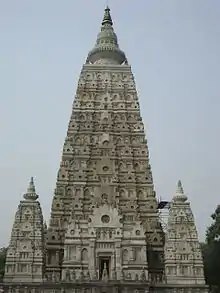
Mount Meru (Sanskrit/Pali: मेरु), also known as Sumeru, Sineru, or Mahāmeru, is the sacred five-peaked mountain of Hindu, Jain, and Buddhist cosmology and is considered to be the centre of all the physical, metaphysical, and spiritual universes.[1] The mountain is also mentioned in some scriptures of non-Indian based religions such as Taoism, which was influenced by the arrival of Buddhism in China.[2] There is no clear identification of Mount Meru with a particular geophysical location.
Many famous Hindu, Jain, and Buddhist temples have been built as symbolic representations of this mountain. The "Sumeru Throne" 須彌座 xūmízuò style base is a common feature of Chinese pagodas. The highest point (the finial bud) on the pyatthat, a Burmese-style multi-tiered roof, represents Mount Meru.
Etymology
Etymologically, 'meru' in Sanskrit is borrowed from Dravidian 'mēl' or 'mēr' meaning 'high'. The proper name of the mountain is Meru (Sanskrit: Meruparvata), to which is added the approbatory prefix su-, resulting in the meaning "excellent Mount Meru" or "sublime Mount Meru".[3] Meru is also the name of the central bead in a mālā.[4]
In other languages
In other languages, Mount Meru is pronounced:
- Assamese: মেৰু পর্বত (Meru Pôrbôt)
- Bengali: মেরু পর্বত (Meru Porbot)
- Burmese: မြင်းမိုရ်တောင် ([mjɪ̰ɴ mò tàʊɰ̃])
- Cebuano: Bukid Meru
- Chinese: 須彌山 (Xūmíshān)
- Gujarati: મેરૂ પર્વત (Meru Parvat)
- Sanskrit, Marathi, Hindi: मेरु पर्वत (Meru Parvat)
- Ilocano: Bantay Meru
- Japanese: 須弥山 (Shumisen)[5]
- Javanese: ꦱꦼꦩꦺꦫꦸ (Semeru)
- Kannada: ಮೇರು ಪರ್ವತ (Meru Parvata)
- Khmer: ភ្នំព្រះសុមេរុ (Phnom Preah Someru) or (Phnom Preah Somae)
- Korean: 수미산 (Sumisan)
- Malayalam: മഹാമേരു പർവ്വതം (Mahameru Parvatham)
- Mongolian: Сүмбэр Уул (Sümber Uul)
- Odia: ମେରୁ ପର୍ବତ (“Meru Pôrbôtô”)
- Old Maldivian: ސުމޭރު-މަންދަރަ "Sumēru-Mandara" (sometimes spelt as Ṣumeru-Mandara)
- Pāli: Sineru
- Punjabi: ਮੇਰੂ ਪਰਬਤ (Meru Parbat)
- Tagalog: Bulkang Meru
- Tamil: மகா மேரு மலை (Maha Meru Malai)
- Telugu: మేరు పర్వతం (Meru Parvatam)
- Sinhala: මහා මේරු පර්වතය (Maha Meru Parvathaya)
- Tibetan: ཪི་རྒྱལ་པོ་རི་རབ་
- Thai: เขาพระสุเมรุ (Khao phra sumen)
- Vietnamese: Núi Tu-di
Geography
The dimensions attributed to Mount Meru — which all refer to it as a part of the Cosmic Ocean, along with several other statements that describe it in geographically vague terms (e.g., "the Sun along with all the planets circle the mountain") — make the determination of its location most difficult, according to most scholars.[6][7]
Several researchers identify Mount Meru or Sumeru with the Pamirs, northwest of Kashmir.[8][9][10][11][12][13][14]
The Suryasiddhanta mentions that Mt. Meru lies at the centre of the Earth ("bhuva-madhya") in the land of the Jambunad (Jambudvīpa). Narapatijayacharyasvarodaya, a ninth-century text, based on mostly unpublished texts of Yāmal Tantr, mentions:
- "Sumeruḥ Prithvī-madhye shrūyate drishyate na tu"
- (Sumeru is heard to be at the centre of the Earth, but is not seen there).[15]
Several versions of cosmology can be found in existing Hindu texts. In all of them, cosmologically, the Meru mountain was also described as being surrounded by Mandrachala Mountain to the east, Suparshva Mountain to the west, Kumuda Mountain to the north, and Kailasa to the south.[16]
In Buddhism

According to Buddhist cosmology, Mount Meru (or Sumeru) is at the centre of the world,[17] and Jambūdvīpa is south of it. It is 80,000 yojanas wide and 80,000 yojanas high according to the Abhidharmakośabhāṣyam[18][19] and 84,000 yojanas high according to the Long Āgama Sutra.[5] Trāyastriṃśa is at its peak, where Śakra resides. The Sun and the Moon revolve around Mount Meru, and as the Sun passes behind it, it becomes nighttime. The mountain has four faces — each one made of a different material; the northern face is made of gold, the eastern one is made of crystal, the southern one is made of lapis lazuli, and the western one is made of ruby.[17]
In Vajrayāna, maṇḍala offerings often include Mount Meru, as they in part represent the entire universe.[20][21] It is also believed that Mount Meru is the home of the Buddha Cakrasaṃvara.[22]
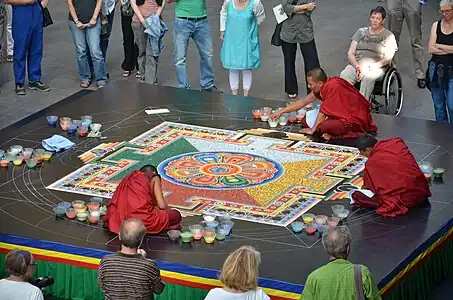
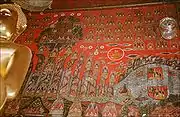
 Tibetan Buddhist embroidery representing Mount Sumeru.
Tibetan Buddhist embroidery representing Mount Sumeru.
In Hinduism
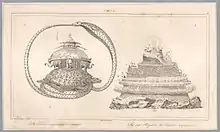
Mount Meru of Hindu traditions is described as 84,000 yojanas high, about 1,082,000 km (672,000 mi), which would be 85 times the Earth's diameter. The Sun and Moon along with all the planets revolve around Mount Meru as one unit.
One yojana can be taken to mean about 11.5 km (9 miles), though its magnitude seems to differ over periods — for example, the Earth's circumference is 3,200 yojanas according to Varahamihira and slightly less so in the Aryabhatiya, but is said to be 5,026.5 yojanas in the Suryasiddhānta. The Matsya Purana and the Bhagavata Purana, along with some other Hindu texts, consistently give the height of 84,000 yojanas to Mount Meru, which translates into 672,000 miles or 1,082,000 kilometers.
Mount Meru was said to be the residence of King Padmaja Brahma in antiquity.[16]
According to Charles Allen, Mount Kailash is identified with Mount Meru. One description in the Vishnu Purana of the mountain states that its four faces are made of crystal, ruby, gold, and lapis lazuli.[23] It is a pillar of the world and is located at the heart of six mountain ranges symbolizing a lotus.[23]
In Jainism
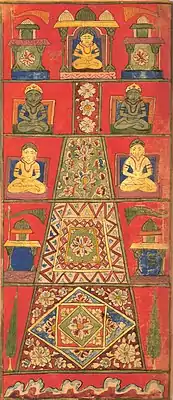
According to Jain cosmology, Mount Meru (or Sumeru) is at the centre of the world surrounded by Jambūdvīpa,[24] in the form of a circle forming a diameter of 100,000 yojanas.[25] There are two sets of sun, moon, and stars revolving around Mount Meru; while one set works, the other set rests behind Mount Meru.[26][27][28]
Every Tirthankara is taken to the summit of Meru by Indra shortly after his birth, after putting the Tirthankara child's mother into a deep slumber. There, he is bathed and anointed with precious functions.[29][30] Indra and other Devas celebrate his birth.
Javanese legends
This mythical mountain of gods was mentioned in the Tantu Pagelaran, an Old Javanese manuscript written in the 15th-century Majapahit period. The manuscript describes the mythical origin of the island of Java, as well as the legendary movement of portions of Mount Meru to Java. The manuscript explains that Batara Guru (Shiva) ordered the gods Brahma and Vishnu to fill Java with human beings. However, at that time, Java island was floating freely on the ocean, always tumbling and shaking. To stop the island's movement, the gods decided to nail it to the Earth by moving the part of Mahameru in Jambudvipa (India) and attaching it to Java.[31] The resulting mountain is Mount Semeru, the tallest mountain in Java.
Architecture

The concept of a holy mountain surrounded by various circles was incorporated into ancient Hindu temple architecture with a Shikhara (Śikhara) — a Sanskrit word translating literally to "peak" or "summit". Early examples of this style can be found at the Harshat Mata Temple and Harshnath Temple from the 8th century CE in Rajasthan, Western India. This concept also continued outside India, such as in Bali, where temples feature Meru towers.
In Buddhist temples, the Mahabodhi Temple in Bodh Gaya is the earliest example of the 5th- to 6th-century depiction. Many other Buddhist temples took on this form, such as the Wat Arun in Thailand and the Hsinbyume Pagoda in Myanmar.
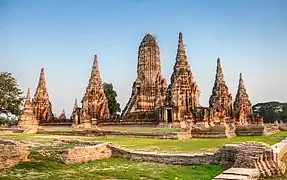 Prang of Wat Chaiwatthanaram, a Buddhist temple in Ayutthaya, Thailand, representing Mount Meru
Prang of Wat Chaiwatthanaram, a Buddhist temple in Ayutthaya, Thailand, representing Mount Meru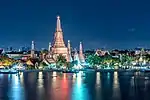
_-_panoramio_(23).jpg.webp)
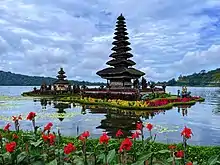
 Depiction of Mount Meru at Jambudweep, a Jain temple in Uttar Pradesh
Depiction of Mount Meru at Jambudweep, a Jain temple in Uttar Pradesh
See also
Notes
- ↑ Gopal, Madan (1990). K.S. Gautam (ed.). India through the ages. Publication Division, Ministry of Information and Broadcasting, Government of India. p. 78.
- ↑ "THƯỢNG THẤT TIÊU TAI TẬP PHÚC DIỆU KINH". thegioivohinh.com. Retrieved 8 March 2023.
- ↑ C., Huntington, John (2003). The circle of bliss : Buddhist meditational art. Bangdel, Dina., Thurman, Robert A. F., Los Angeles County Museum of Art., Columbus Museum of Art. Chicago: Serindia Publications. ISBN 1932476016. OCLC 52430713.
{{cite book}}: CS1 maint: multiple names: authors list (link) - ↑ "Meru". Sanskrit Dictionary. Retrieved 16 August 2019.
- 1 2 "Mount Sumeru". Nichiren Buddhism Library. Retrieved 17 August 2019.
- ↑ Sachau, Edward C. (2001). Alberuni's India. Psychology Press. p. 271. ISBN 978-0-415-24497-8.
- ↑ "The Devi Bhagavatam". Sacred-texts.com. Book 8, Chapter 15. Retrieved 2 March 2012.
- ↑ Chapman, Graham P. (2003). The Geopolitics of South Asia: From early empires to the nuclear age. Ashgate Publishing. p. 16. ISBN 9781409488071.
- ↑ Curzon, George Nathaniel (1968). The Hindu World: An encyclopedic survey of Hinduism. p. 184.
- ↑ Walker, Benjamin (1969). Hinduism: Ancient Indian tradition & mythology. Purāṇas in Translation. p. 56.
- ↑ Shastri, Jagdish Lal; Kunst, Arnold; Bhatt, G.P.; Tagare, Ganesh Vasudeo (1928). "Oriental literature". Journal of the K.R. Cama Oriental Institute: 38.
- ↑ Rosenthal, Bernice Glatzer (1967). History: Geographical concepts in ancient India. p. 50.
- ↑ Dube, Bechan (1972). India: Geographical data in the early Purāṇas: A critical study. p. 2.
- ↑ Singh, M.R., Dr. (1971). India: Studies in the proto-history of India. p. 17.
{{cite book}}: CS1 maint: multiple names: authors list (link) - ↑ cf. second verse of Koorma-chakra in the book Narpatijayacharyā
- 1 2 Mittal, J.P. History of Ancient India: From 7300 BC to 4250 BC. p. 3.
- 1 2 Robert Beer (2003). The Handbook of Tibetan Buddhist Symbols. Boston: Shambhala. pp. 83–84. ISBN 978-1590301005.
- ↑ Vasubandhu (1988–1990). Abhidharmakośabhāṣyam. Berkeley, California: Asian Humanities Press.
- ↑ "The View from Mount Meru". Lions Roar. 20 August 2013. Retrieved 17 August 2019.
- ↑ "What Is a Mandala?". studybuddhism.com.
- ↑ "Preliminary practice (ngöndro) overview". September 2009. Retrieved 10 October 2016.
- ↑ "Heruka Chakrasamvara". Khandro.net. Retrieved 2 March 2012.
- 1 2 Allen, Charles. (1982). A Mountain in Tibet, pp. 21–22. André Deutsch. Reprint: 1991. Futura Publications, London. ISBN 0-7088-2411-0.
- ↑ Cort 2010, p. 90.
- ↑ Schubring, Walther (1995), pp. 204–246
- ↑ CIL, "Indian Cosmology Reflections in Religion and Metaphysics", Ignca.nic.in, archived from the original on 30 January 2012
- ↑ Shah, Pravin K., Jain Geography (PDF), archived (PDF) from the original on 19 November 2002
- ↑ Journal of the Asiatic Society of Bengal - Asiatic Society of Bengal, 1834
- ↑ Welch, Stuart Cary; Metropolitan Museum Of Art (New York, N.Y.) (1985). India: Art and Culture, 1300-1900. Metropolitan Museum of Art. ISBN 9780030061141.
- ↑ "Jainism Literature Center - Rituals". Archived from the original on 16 August 2019. Retrieved 16 August 2019.
- ↑ Soekmono, Dr R. (1973). Pengantar Sejarah Kebudayaan Indonesia 2. Yogyakarta, Indonesia: Penerbit Kanisius. p. 119. ISBN 979-413-290-X.
Sources
- Cort, John (2010) [1953], Framing the Jina: Narratives of Icons and Idols in Jain History, Oxford University Press, ISBN 978-0-19-538502-1.
- Narpatijayacharyā, commentary by Ganeshdatta Pathak, Published by Chowkhambha Sanskrit Sansthana, Varanasi, India, PIN-221001.
External links
- Description of Mount Meru in the Devi-bhagavata-purana 12
- Painting of Mount Meru found in Buddhist cave sanctuary in Xinjiang, China
- Mount Meru in Encyclopedia of Buddhist Iconography 12
- Sumeru in Encyclopedia of Buddhist Iconography 12
- Ngari
- Tibetan Cosmological Models Archived 31 March 2018 at the Wayback Machine
- What is Mount Meru?
